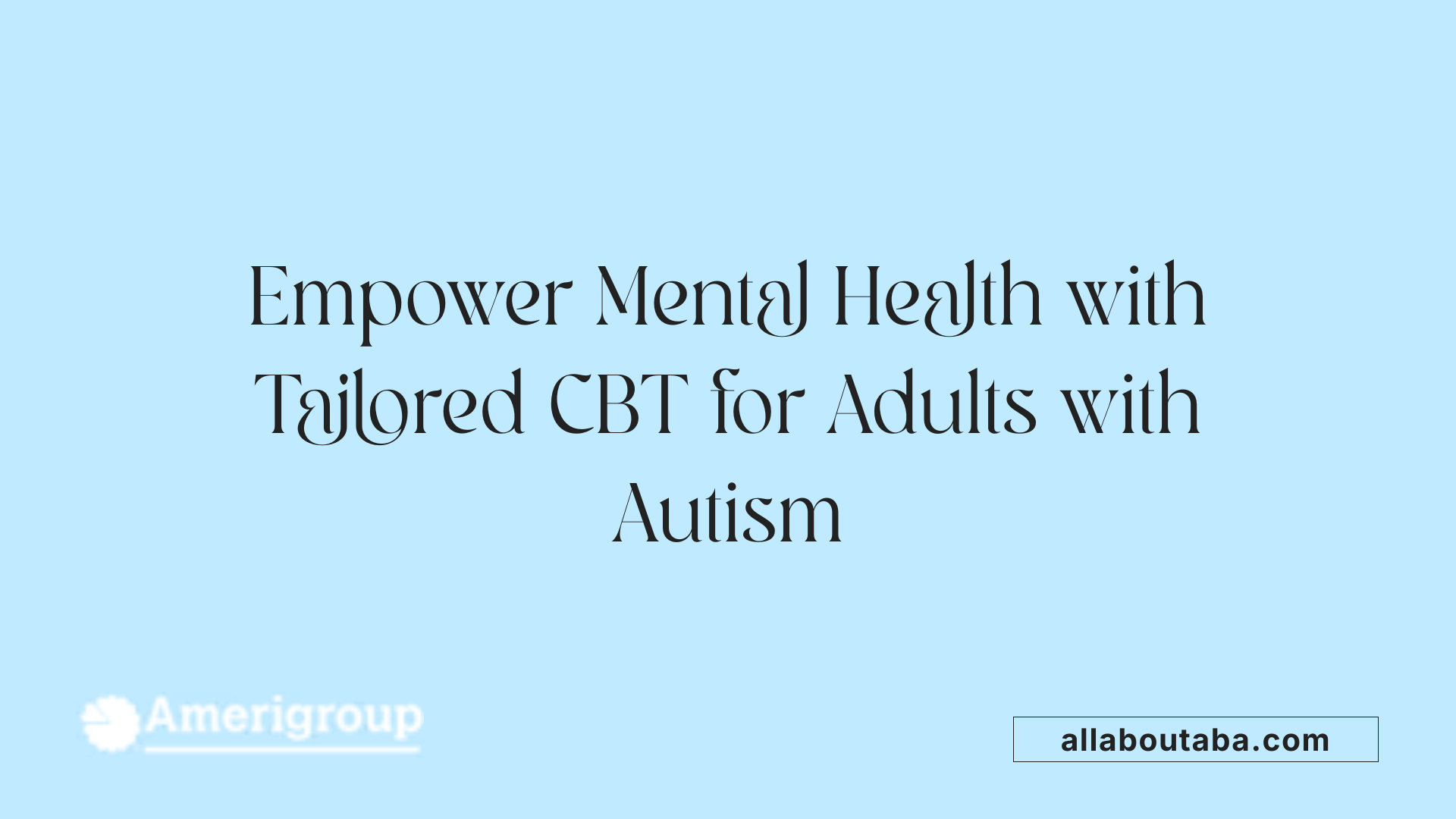Autism And The Benefits Of Structured Leisure Activities
Exploring the Vital Role of Leisure and Therapy in Autism Support
Structured leisure activities and therapeutic interventions play a pivotal role in enhancing the quality of life for individuals with autism spectrum disorder (ASD). These approaches, backed by research and clinical practices, foster independence, social skills, and emotional well-being. Our article delves into the multifaceted benefits of combining behavioral therapies such as Applied Behavior Analysis (ABA) and Cognitive Behavioral Therapy (CBT) with recreation therapy, especially structured leisure activities and exercise, to empower adults with autism.
Understanding Applied Behavior Analysis (ABA) Therapy in Autism Support
What is Applied Behavior Analysis (ABA) therapy and how is it used to support individuals with autism?
Applied Behavior Analysis (ABA) therapy is a scientifically supported intervention that applies principles of learning and behavior to assist individuals with autism. The primary goal of ABA is to help develop essential skills and reduce behaviors that may interfere with daily functioning and learning.
Definition of ABA therapy
ABA involves analyzing behavior patterns and understanding the causes behind them — focusing on how environmental factors influence actions. Therapists use this information to introduce new skills and reinforce positive behaviors through structured techniques.
Core techniques involved in ABA
Key strategies include:
- Positive reinforcement: Rewarding desirable behaviors to encourage repetition.
- Antecedent analysis: Identifying triggers that lead to behaviors.
- Consequence management: Changing outcomes to influence future actions.
- Discrete Trial Training (DTT): Breaking skills into small, teachable steps.
- Pivotal Response Treatment (PRT): Targeting pivotal skills to produce widespread improvements.
- Naturalistic interventions: Teaching within everyday activities to generalize skills.
Areas targeted by ABA
ABA programs focus on a variety of domains such as:
- Communication skills
- Social interactions
- Self-care and daily living skills
- Academic abilities
- Reduction of challenging behaviors
Role of individualized programs
Each ABA therapy plan is personalized based on an individual's unique strengths, challenges, and goals. These programs are carefully designed and monitored by board-certified behavior analysts (BCBAs) to ensure effective and ethical practice.
Effectiveness and goals of ABA
Research demonstrates that ABA therapy can lead to meaningful improvements in language, social functioning, and independence. While ABA is often intensive and long-term, current approaches emphasize building on individual strengths, promoting autonomy, and customizing strategies to meet participant needs.
| Aspect | Description | Purpose |
|---|---|---|
| Positive Reinforcement | Rewarding desirable behaviors | Encourage repetition of positive skills |
| Antecedent Analysis | Identifying triggers for behaviors | Prevent or modify problematic behaviors |
| Discrete Trial Training | Teaching skills in small, structured steps | Facilitate focused learning of specific tasks |
| Individualized Plans | Tailored therapy based on assessments | Address unique needs and foster strengths |
| Outcome Focus | Improving communication, social, and daily living skills | Enhance independence and quality of life |
Qualified Professionals Behind ABA Therapy Delivery

Who typically provides ABA therapy and what qualifications do these professionals have?
Applied Behavior Analysis (ABA) therapy is primarily provided by licensed professionals known as Licensed Behavior Analysts (LBAs). These experts have earned master’s degrees and undergone specialized education in behavioral analysis. They also complete supervised hands-on experience and pass state examinations to receive their certification.
LBAs are responsible for designing, supervising, and evaluating individualized ABA treatment plans. These plans focus on improving socially significant behaviors tailored to each person's needs. They ensure the therapy is ethically sound and effectively delivered.
In addition to LBAs, Registered Behavior Technicians (RBTs) support therapy by following scripts during sessions, collecting data, and assisting clients. Although RBTs are unlicensed personnel, they work under the close supervision of LBAs.
The regulatory framework for ABA therapy varies by state. For example, in New York, the provision of ABA services is governed by law requiring practitioners to be licensed, certified, or qualify for exemptions. Some licensed professionals trained in ABA may practice under these exemptions.
This layered system of qualified providers and support staff ensures that ABA therapy is ethically implemented and tailored to individual requirements, maximizing beneficial outcomes for clients.
Benefits and Challenges of ABA Therapy for Individuals with Autism
What are some of the benefits and potential challenges of ABA therapy for individuals with autism?
Applied Behavior Analysis (ABA) therapy provides significant benefits for individuals with autism spectrum disorder (ASD). It helps improve communication and social skills, reduces challenging behaviors such as aggression or self-injury, and supports increasing independence. The therapy is tailored to each individual’s needs, using positive reinforcement and structured teaching to build a wide range of essential life skills.
ABA is effective across different age groups and functioning levels, assisting both nonverbal and high-functioning individuals. Improvements are seen not only in behavioral areas but also in emotional regulation and academic achievement. Caregiver involvement plays a vital role, as it ensures consistency and fosters a supportive environment that strengthens family bonds.
However, ABA therapy comes with challenges. The time commitment can be intensive, often requiring many hours per week, which may be difficult for families to sustain. Personalizing the therapy to fit each person’s unique needs requires ongoing adjustments and skilled professionals. Ethical considerations are also crucial to ensure the therapy respects the dignity and preferences of the individual, avoiding overly rigid or restrictive practices.
In summary, ABA therapy is a proven, evidence-based approach with powerful benefits, but success depends on careful implementation, family participation, and a balanced respect for the individual's autonomy and well-being.
Cognitive Behavioral Therapy (CBT): Tailoring Mental Health Support for Adults with Autism

What is CBT and how is it used for adults with ASD?
Cognitive Behavioral Therapy (CBT) is a structured, goal-oriented psychotherapy designed to help individuals identify and change unhelpful thought patterns and behaviors. For adults with Autism Spectrum Disorder (ASD), CBT is adapted to suit their unique needs, focusing on managing mental health conditions and improving daily functioning.
How does CBT address co-occurring anxiety and depression?
Many adults with ASD experience anxiety and depression alongside autism. CBT targets these co-occurring conditions by reshaping negative thought patterns and teaching symptom management techniques. This dual focus helps improve overall emotional well-being.
What adaptations are made to CBT for autism?
To effectively serve adults with ASD, CBT incorporates adaptations such as:
- Using visual aids to support understanding.
- Employing concrete, clear language.
- Structuring sessions with predictable formats.
- Integrating social skills training to address communication challenges and sensory sensitivities. These modifications make therapy more accessible and relevant.
What techniques does CBT use to support adults with autism?
CBT employs several practical strategies, including:
- Cognitive restructuring: Challenging and changing negative thoughts.
- Behavioral experiments: Testing beliefs through real-world activities.
- Exposure therapy: Gradual confrontation of feared situations to reduce anxiety. These techniques enhance emotional regulation, social skills, and coping mechanisms.
What does research say about the effectiveness of CBT for adults with ASD?
Evidence from randomized controlled trials shows that when properly tailored, CBT effectively reduces anxiety and depression in adults with autism. The therapy's adaptations and techniques have been scientifically supported to improve mental health outcomes in this population.
Enhancing Emotional Regulation and Coping Skills through CBT
How Does CBT Improve Emotional Regulation in Adults with ASD?
CBT helps adults with autism spectrum disorder (ASD) improve emotional regulation by teaching them to recognize and modify unhelpful thought patterns. This process, known as cognitive restructuring, enables individuals to manage emotional responses more effectively and reduces the intensity and frequency of distressing emotions.
How Does CBT Support Social Skills Development?
CBT for adults with ASD often includes social skills training as part of the structured sessions. By using concrete language and visual aids, therapists guide clients in understanding social cues and practicing appropriate social behaviors, which can improve interpersonal relationships and communication.
In What Ways Does CBT Enhance Coping Mechanisms?
Behavioral experiments and exposure therapy are techniques within CBT that allow individuals to gradually face challenging situations or fears under professional guidance. This systematic approach builds resilience and equips adults with ASD to handle stressors and unexpected experiences more confidently.
What Is the Impact of CBT on Mental Health Symptoms?
Many adults with ASD struggle with anxiety and depression. Research shows that tailored CBT effectively reduces these symptoms by reshaping negative thinking patterns and providing tools to manage daily challenges. Evidence from randomized controlled trials supports the therapy's efficacy when adapted to meet the needs of the autistic population.
What Specific Techniques Are Utilized in CBT?
- Cognitive restructuring to challenge negative thoughts
- Behavioral experiments to test new behaviors
- Exposure therapy to gradually reduce fear and anxiety These methods collectively improve emotional regulation, social interaction, and adaptive coping strategies.
The Power of Structured Leisure Activities in Autism Support

Why Are Leisure Activities Important for Adults with Autism?
Leisure activities provide essential opportunities for adults with autism spectrum disorder (ASD) to engage socially and develop critical communication skills. These structured activities offer a fun and supportive environment where emotional recognition and interaction can be practiced in meaningful ways.
How Does Offering Choice and Autonomy Benefit Individuals?
Allowing autistic adults to choose their leisure activities—such as games, crafts, or community events—enhances enjoyment and engagement. This independence not only boosts morale but also initiates a positive cycle where individuals feel empowered to explore their interests and strengths without excessive reliance on caregivers.
What Impact Do These Activities Have on Social and Communication Skills?
Engagement in self-chosen leisure activities significantly improves the ability to recognize and label emotions. For example, participants in a yearlong program scored roughly 24% higher in recognizing emotions and 50% higher in labeling them compared to controls. These gains translate into better interpersonal understanding and more effective communication.
How Do Structured Leisure Activities Promote Independence and Self-Determination?
Encouraging independent decision-making in choosing leisure pursuits fosters self-determination. This autonomy is linked to greater personal fulfillment and encourages ongoing development of coping and social skills. Such independence supports broader life skills, including emotional regulation and self-advocacy.
Which Psychological Theories Support the Importance of Autonomy?
The benefits of autonomy in leisure choices are rooted in psychological theories by scholars like Edward Deci and Mihaly Csikszentmihalyi. Their work emphasizes that self-determination and intrinsic motivation are vital for human well-being and growth, reinforcing the value of giving individuals greater control over their recreational experiences.
Measurable Progress through Recreation Programs for Adults with Autism

What was the yearlong recreation program like for autistic adults?
This yearlong program provided autistic adults the freedom to choose from a variety of leisure activities such as games, crafts, and events. This choice-based approach was central to fostering independence rather than dependence on caregivers.
Which activities were included and why?
Participants engaged in diverse activities including board games that encouraged strategic thinking and social interaction, crafts that fostered creativity and fine motor skills, and special events that promoted community involvement and communication skills.
How did participation impact emotional recognition and labeling?
The program led to significant improvements in emotional skills. Specifically, participants scored approximately 24% higher than a control group in recognizing emotions, and 50% higher in labeling them. These results demonstrate measurable progress in emotional intelligence.
What do the statistics tell us about the program’s effectiveness?
These statistical outcomes from the program highlight its effectiveness in enhancing core emotional skills critical for social functioning in adults with autism. The notable improvements underscore the success of a choice-driven leisure activity model.
What are the long-term benefits of participating in such recreation programs?
Long-term benefits include increased autonomy, improved social communication, and better emotional understanding. Encouraging self-determination aligns with psychological theories by Edward Deci and Mihaly Csikszentmihalyi, emphasizing the importance of autonomy for human fulfillment. Overall, these programs support ongoing personal growth and self-advocacy.
Exercise as a Therapeutic Intervention in Autism Recreation Therapy
How Does Exercise Promote Social, Emotional, and Independent Skills Development?
Exercise has been shown to significantly promote growth in social interaction, emotional regulation, and independence among individuals with autism. By engaging in physical activity, participants develop essential skills such as organization, motor control, and self-advocacy, which contribute to greater autonomy in daily life tasks.
In What Ways Are Exercise-Based Interventions Tailored?
Recreation therapy involving exercise is carefully customized to each individual's needs and abilities. These tailored programs help build leisure skills and boost confidence by aligning activities with personal goals, ensuring participants remain motivated and engaged throughout their therapeutic experience.
What Adaptive Sports and Recreational Activities Are Used?
Adaptive sports including tennis, golf, swimming, and obstacle courses play a vital role. These activities not only improve physical health and motor skills but also nurture social skills by providing opportunities for interaction and teamwork in structured, supportive environments.
How Do Visual Supports and Structured Settings Enhance Exercise Programs?
Visual supports and structured settings are integrated into therapeutic exercise routines to reduce anxiety and facilitate communication. These tools create predictable and clear environments, helping individuals with autism better understand expectations and engage more fully in activities.
What Positive Outcomes Stem From Exercise-Based Recreation Therapy?
Participation in exercise-based recreation therapy leads to increased self-confidence and empowerment. These psychological benefits often carry over into other life areas, enhancing social communication and overall quality of life. The combination of physical activity and structured support encourages ongoing independence and personal growth among individuals with autism.
How Therapeutic Exercise Supports Independence and Daily Skills

Skill development in organization and motor control
Therapeutic exercise provides structured opportunities for individuals with autism to develop critical organizational and motor skills. Activities such as adaptive sports—including tennis, golf, swimming, and obstacle courses—are designed to enhance coordination and physical control, which directly support everyday functioning. These exercises often require following instructions, planning movements, and maintaining focus, all of which contribute to improved organization and physical capabilities.
Self-advocacy and daily living tasks
Recreation therapy empowers individuals to take greater control over their lives by fostering self-advocacy. Through engaging in personalized exercise programs, participants learn to communicate their preferences and needs more effectively. This increased confidence translates into better management of daily living tasks such as personal care and household chores. The autonomy gained during sessions encourages participants to apply these skills independently in their everyday environments.
Reduction of anxiety through communication tools
Exercise therapy programs integrate communication tools and visual supports that reduce anxiety and facilitate clearer expression. Structured settings with consistent routines make the environment predictable, helping participants feel more secure. These adaptations improve engagement, allowing individuals to participate more fully while managing sensory sensitivities common in autism.
Enhanced engagement and participation
By incorporating enjoyable and meaningful physical activities tailored to individual interests and needs, therapeutic exercise increases motivation and involvement. The combination of physical movement with supportive communication strategies encourages sustained participation, which is crucial to skill mastery and confidence building.
Integration of exercise with therapy goals
Therapeutic exercise is intentionally aligned with broader therapy goals, such as emotional regulation, social skills development, and coping mechanisms. This holistic approach ensures that physical activity not only promotes health but also reinforces psychological and social growth. Research demonstrates that such integrated programs contribute significantly to improving quality of life and fostering independence in adults with autism.
Integrating Behavioral and Recreation Therapies for Holistic Autism Support
How do CBT and recreation therapy work together for adults with autism?
Cognitive Behavioral Therapy (CBT) and recreation therapy each address distinct but overlapping needs for adults with Autism Spectrum Disorder (ASD). While CBT focuses on restructuring negative thought patterns and managing mental health conditions like anxiety and depression, recreation therapy emphasizes physical activity and leisure to boost social and motor skills. Used together, these therapies create a comprehensive support system that targets emotional wellbeing and physical development.
What skills are developed through a comprehensive approach?
A multifaceted therapy plan builds a wide range of skills:
- Emotional regulation via CBT techniques such as cognitive restructuring and exposure therapy.
- Social interaction skills through structured social skills training and group recreational activities.
- Physical abilities through adaptive sports like tennis and swimming.
- Communication improvements supported by visual aids and structured settings in both therapy types.
How are emotional, social, and physical needs addressed?
CBT specifically targets anxiety and depression by modifying negative thoughts and behaviors. Recreation therapy enhances engagement through activities chosen by the individual, promoting autonomy and emotional expression. Exercise-based interventions develop motor skills and increase self-confidence, which, in turn, improve social interactions. Together, these therapies harmonize psychological and physical health aspects crucial for adults with autism.
How do these therapies promote quality of life and autonomy?
Allowing individuals to select leisure activities during recreation therapy fosters independence and self-determination—principles grounded in psychological theories by Deci and Csikszentmihalyi. Improved emotional recognition and labeling skill gains from recreation programs further empower individuals to navigate social environments more effectively. CBT’s role in emotional management complements this, resulting in enhanced overall quality of life.
What are future directions for integrated autism treatments?
Emerging approaches emphasize tailoring therapies to individual needs by combining behavioral strategies with physical and recreational activities. Integrating visual supports and structured communication tools enhances both therapies’ effectiveness. Ongoing research aims to optimize these collaborations to facilitate sustained independence, emotional resilience, and social engagement for adults on the spectrum.
| Therapy Type | Focus Areas | Techniques and Benefits |
|---|---|---|
| Cognitive Behavioral Therapy (CBT) | Emotional regulation, anxiety, depression | Cognitive restructuring, exposure therapy, social skills training |
| Recreation Therapy | Physical development, motor skills, social interaction | Adaptive sports, leisure activity choice, exercise programs |
| Combined Approach | Holistic development | Addresses emotional, social, and physical needs; promotes autonomy and quality of life |
Creating Supportive Environments that Foster Autonomy in Autism
Role of caregiver support versus independence
In autism therapy, balancing caregiver assistance with promoting independence is crucial. While caregivers provide essential support, fostering autonomy allows adults with ASD to develop self-confidence and reduce reliance on others. Programs that encourage individuals to make their own choices, especially in leisure activities, contribute to this growing independence and personal growth.
Encouraging self-determination
Self-determination plays a vital role in fulfilling the emotional and developmental needs of adults with autism. By enabling individuals to decide their preferred activities, therapy enhances motivation and engagement. Such empowerment leads to measurable improvements, such as increased ability to recognize and label emotions, as demonstrated by participants scoring significantly higher than control groups in structured programs.
Importance of structured settings and visual aids
Structured therapy sessions tailored for ASD often incorporate visual supports and clear, concrete language, adapting to communication and sensory sensitivities. These modifications create predictable and safe environments that reduce anxiety and facilitate learning. They provide a framework where clients can thrive while gradually expanding their independence.
Empowerment through choice in therapy and leisure
Offering choices during therapy and recreational programs enables autistic adults to engage meaningfully and feel in control. Whether it is selecting between games, crafts, or events, allowing autonomy promotes enjoyment and social skills development. This approach fosters a positive feedback loop where increased autonomy encourages further independence.
Applying psychological theories of motivation and fulfillment
The principles of self-determination theory, championed by Edward Deci and Mihaly Csikszentmihalyi, underscore the importance of autonomy in psychological well-being. Therapy programs that embrace these theories support intrinsic motivation and personal fulfillment by allowing individuals with autism to steer their therapeutic journeys.
| Aspect | Approach | Benefit |
|---|---|---|
| Caregiver Support | Balanced with promoting autonomy | Builds confidence and reduces dependency |
| Structured Settings | Use of visuals and concrete language | Reduces anxiety and improves communication |
| Choice in Activities | Offering options in therapy and leisure | Enhances motivation and social skills |
| Psychological Motivation | Self-determination theory principles | Increases engagement and personal satisfaction |
The Transformative Impact of Structured Leisure and Therapy on Autism Support
Structured leisure activities combined with evidence-based therapies such as ABA and CBT create powerful opportunities for adults with autism to develop vital skills, improve mental health, and gain greater independence. By fostering autonomy through choice, leveraging tailored interventions, and emphasizing the holistic integration of behavioral and recreation therapies, individuals with autism can experience measurable progress in social communication, emotional regulation, and overall quality of life. These approaches honor the principles of self-determination and empowerment, offering a hopeful path forward in autism support and therapeutic practice.
References
- Cognitive Behavioral Therapy For Adults With Autism ...
- Freedom to choose leisure activities benefits people with ...
- Exploring Recreation Therapy for Individuals with Autism
- Guidance on the Roles of Licensed Providers and Unlicensed ...
- Applied Behavior Analysis (ABA)
- How to Become an ABA Therapist - School of Education
- 5 Benefits Of ABA Therapy For Autism
Other articles
Recent articles

The Role Of Teachers In Fostering Autism Peer Acceptance

Using Art Therapy To Support Children With Autism

Autism And Strategies For Addressing Sensory Defensiveness

Autism And The Benefits Of Structured Leisure Activities

How To Support Autistic Students During Exam Season

Autism And Goal Setting For Personal Growth

How To Use Gamification In Autism Learning Programs

How Schools Can Reduce Bullying Of Autistic Students

Early Intervention Strategies For Autism Spectrum Disorder

The Role Of Therapists In Autism Life Skills Coaching

How To Support Autistic Individuals In Crisis Situations

Autism And Self-Care Routines For Stress Management

Understanding Echolalia And Its Role In Autism Communication

Autism And Fine Arts Education Benefits

The Impact Of Multisensory Learning On Autism Education

How Family Counseling Supports Autism Household Dynamics

Best Practices For Inclusive Playgrounds For Autism

Best Practices For Autism-Friendly Shopping Centers

How Autism Affects Fine Motor Skill Development

Best Ways To Introduce Sensory Activities Into Daily Routines

How Sports Teams Can Be Inclusive Of Autistic Players

Autism And Strategies For Building Workplace Resilience

Autism And The Impact Of Hormonal Changes During Puberty

How To Support Autistic Students In Foreign Language Classes

Best Ways To Teach Money Skills To Teens With Autism

Supporting Siblings Of Children With Autism

Autism And Co-Occurring Gastrointestinal Disorders

The Role Of Art Projects In Autism Sensory Integration

How Schools Can Incorporate Sensory Break Spaces

Best Practices For Autism Sensory Regulation At School

Autism And Strategies For Teaching Organizational Skills

Understanding The Relationship Between Autism And Anxiety Disorders

Autism And Life Planning For Long-Term Care

Exploring Visual Supports In Autism Education

Ways To Encourage Social Interaction In Children With Autism

The Connection Between Autism And Dyscalculia

The Role Of Occupational Therapy In Transition Planning For Autism

The Role Of Physical Therapists In Autism Motor Skills Support

How To Teach Decision-Making Skills To Autistic Young Adults

The Connection Between Autism And Epilepsy

Best Practices For Transitioning Autistic Children Into New Schools

Autism And Time Management Challenges In Adulthood

The Role Of Visual Arts In Autism Communication Development

How To Address Tactile Defensiveness In Autism

Best Practices For Telehealth Autism Therapy

How To Help Autistic Children Develop Friendship Skills

How Schools Can Support Autistic Students In Career Prep

Best Strategies For Autism-Friendly Event Planning

Understanding Noncontingent Reinforcement In Autism Behavior Plans

How Drama Therapy Benefits Autistic Individuals

Best Practices For Autism-Friendly Fitness And Recreation Centers

Best Ways To Promote Healthy Social Media Use For Autistic Teens

How To Help Autistic Children Cope With Public Speaking

Autism And Strategies For Managing Unexpected Changes

Best Podcasts About Autism For Parents And Educators

Autism And The Impact Of Seasonal Changes On Behavior

The Role Of Diet In Managing Co-Occurring Conditions With Autism

Sleep Challenges In Autism And Practical Solutions

Best Ways To Build Daily Routines For Autistic Children

Best Practices For Supporting Autistic Entrepreneurs

Autism And Strategies For Navigating Large Social Gatherings

Adaptive Sports And Recreational Activities For People With Autism

Autism And The Benefits Of Story-Based Learning Activities

Understanding The Role Of Play In Autism Development

Autism And The Impact Of Environmental Noise On Learning

How To Create Autism-Friendly Community Spaces

Autism And Chronic Health Conditions: What To Know

The Role Of Care Managers In Autism Life Planning

How To Teach Social Boundaries To Autistic Children

How Autistic Individuals Experience Empathy Differently

How To Support Autistic Employees In Remote Work Settings

Autism And The Relationship Between Motor Skills And Learning

How To Create Community Resource Guides For Autism Families

How To Teach Daily Living Skills To Autistic Teens

Autism And The Impact Of Mind-Body Practices On Stress Reduction

Autism And The Benefits Of Outdoor Group Activities

How To Create Autism-Friendly Sensory Paths In Schools

Best Practices For Autism-Friendly Park And Recreation Areas

Autism And Strategies For Reducing School Refusal

Supporting Autistic Individuals In Public Speaking

The Role Of Diet In Managing Autism Symptoms

The Benefits Of Gardening Clubs For Autism Social Development

How To Prepare Autistic Children For Dental Visits

Autism And Employment: Career Paths That Work

Best Practices For Autism-Friendly Hotels And Lodging

The Impact Of Screen Time On Autism Development

Autism Screening Tools For Early Childhood

The Role Of Physical Exercise In Autism Therapy

Best Strategies For Supporting Autistic College Students

The Role Of Technology In Autism Early Detection

Sensory-Friendly Classroom Design Ideas For Autistic Students

The Role Of Speech Therapy In Building Social Communication Skills

Best Strategies For Handling Autistic Burnout In Adults

Autism And The Importance Of Predictability In Routine

Autism And Peer Education: Teaching Acceptance In Schools

Best Practices For Sensory-Friendly Libraries And Reading Rooms

Self-Advocacy Skills For Autistic Adults

The Role Of Technology In Autism Peer Communication

Promoting Physical Activity In Children With Autism

How To Prepare Autistic Children For Medical Procedures
We’re All About You, Your Family, and Your Child

